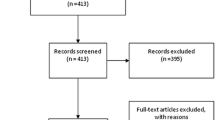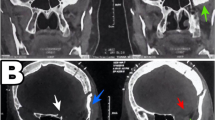Abstract
Purpose
The aim of this study is to assess the efficacy and safety of surgical treatment of orbital cavernomas in terms of clinical and functional results.
Methods
Twenty consecutive patients underwent surgical removal of a unilateral orbital cavernoma between 1999 and 2009. Indications for surgical treatment were: visual impairment, diplopia due to ocular movement impairment, progressive and disfiguring unilateral proptosis, severe retroorbital pain clearly related to the orbital cavernoma. We used a topographic classification of the lesions within the orbit. The orbit has been divided into an anterior and a posterior compartment on the axial plane and into three sectors on the coronal plane. The proptosis was quantified on MRI scans.
Results
The location of the cavernoma determined the choice of the surgical approach. We performed eight lateral orbitotomies and 12 fronto-orbito-zygomatic approaches. All the tumors were completely removed as assessed at follow-up MRI. We did not record any intraoperative or major postoperative complication requiring a reoperation. The postoperative visual acuity improved in four of five patients with visual impairment, it worsened in the other case. Proptosis improved in all the patients. Diplopia improved in four patients, and did not recover in another case.
Conclusion
Surgical treatment of symptomatic orbital cavernomas is safe and effective. Tumor location dictates the choice of surgical approach. Visual function and cosmetic result are the main parameters to evaluate the clinical outcome. Surgical approach and dissection technique are crucial in determining the visual outcome.



Similar content being viewed by others
References
Acciarri N, Giulioni M, Padovani R, Gaist G, Pozzati E, Acciarri R (1995) Orbital cavernous angiomas: surgical experience on a series of 13 cases. J Neurosurg Sci 39(4):203–209
Alfred PR, Char DH (1996) Cavernous hemangiomas of the orbit. Orbit 15:59–66
Ansari SA, Pak J, Shields M (2005) Pathology and imaging of the lacrimal drainage system. Neuroimaging Clin N Am 15(1):221–237
Arai H, Sato K, Katsuta T, Rhoton AL Jr (1996) Lateral approach to intraorbital lesions. Anatomic and surgical considerations. Neurosurgery 39(6):1157–1162
Berke RN (1953) A modified Krönlein operation. Trans Am Ophthalmol Soc 51:193–226
Brusati R, Goisis M, Biglioli F, Guareschi M, Nucci P, Gianni AB, Miglior S (2007) Surgical approaches to cavernous haemangiomas of the orbit. Br J Oral Maxillofac Surg 45(6):457–462
Carta F, Siccardi D, Cossu M, Viola C, Maiello M (1998) Removal of tumors of the orbital apex via a postero-lateral orbitotomy. J Neurosurg Sci 42(4):185–188
Casper DS, Chi TL, Trokel SL (1993) Orbital disease, imaging and analysis. Thieme, New York, pp 81–97
Di Tommaso L, Scarpellini F, Salvi F, Ragazzini T, Foschini MP (2000) Progesterone receptor expression in orbital cavernous hemangiomas. Virchows Arch 436(3):284–288
Ducrey N (1995) Vascular tumors of the orbit. Klin Monbl Augenheilkd 206(5):391–393
Gdal-On M, Gelfand YA (1998) Surgical outcome of transconjunctival cryosurgical extraction of orbital cavernous hemangioma. Ophthalmic Surg Lasers 29:969–973
Gûnlap I, Gûndûz K (1995) Vascular tumors of the orbit. Doc Ophthalmol 89(4):337–345
Harris GJ, Jakobiec FA (1979) Cavernous hemangioma of the orbit. J Neurosurg 51(2):219–228
Hejazi N, Classen R, Hassler W (1999) Orbital and cerebral cavernomas: comparison of clinical neuroimaging, and neurophyalmological features. Neurosurg Rev 22(1):28–33
Henderson JW (1980) Orbital tumors, 2nd edn. Thieme Stratton, New York, pp 115–176
Kennerdell JS, Maroon JC, Celin SE (1998) The posterior inferior orbitotomy. Ophthalmic Plastic Reconstr Surg 14(4):277–280
Kersten RC, Kulwin DR (1995) Surgical management of orbital cavernous angiomas: prognosis for visual function after removal. Neurosurgery 36(5):1058
Kiratli H, Bulur B, Bilgiç S (2005) Transconjunctival approach for retrobulbar intraconal orbital cavernous hemangiomas. Orbital surgeon’s perspective. Surg Neurol 64(1):71–74
Kopelow SM, Foos RY, Straatsma BR, Hepler RS, Pearlman JT (1971) Cavernous hemangioma of the orbit. Int Ophthalmol Clin 11(3):113–124
Kronlein RU (1889) Zur Pathologie und operativen Behandlung der Dermoidcysten der Orbita. Beitr Klin Chir 4:149–163
Leatherbarrow B, Noble JL, Lloyd IC (1989) Cavernous haemangioma of the orbit. Eye 3:90–99
MacNab AA, Wright J (1989) Cavernous hemangiomas of the orbit. Aust N Z J Ophtalmol 17:337–345
Maroon JC, Kennerdell JS (1984) Surgical approaches to the orbit. Indications and techniques. J Neurosurg 60(6):1226–1235
Mir-Salim PA, Berghaus A (1999) Endonasal, microsurgical approach to the retrobulbar region exemplified by intraconal hemangioma. HNO 47(3):192–195
Missori P, Tarantino R, Delfini R, Lunardi P, Cantore G (1994) Surgical management of orbital cavernous angiomas: prognosis for visual function after removal. Neurosurgery 35(1):34–38
Moss HM (1962) Expanding lesions of the orbit. A clinical study of 230 consecutive cases. Am J Ophthalmol 54:761–770
Ni C, Ma X (1995) Histopathologic classification of 1921 orbital tumors. Yen Ko Hsueh Pao 11(2):101–104
Orcutt JC, Wulc AS, Mills RP, Smith CH (1991) Asymptomatic orbital cavernous hemangiomas. Ophthalmology 98(8):1257–1260
Ozgen A, Aydingöz U (2000) Normative measurements of orbital structures using MRI. J Comput Assist Tomogr 24(3):493–496
Reese AB (1976) Tumors of the eye. Harper and Row, Maryland, p 272
Rootman J (2003) Vascular malformations of the orbit: hemodynamic concepts. Orbit 22(2):103–120
Rootman J (1988) Vascular lesions. In: Rootman J (ed) Deseases of the orbit. JB Lippincott Company, Philadelphia, pp 532–533
Ruban JM, Navailles B, Yalazkan B (1992) Large orbito-palpebral cavernous hemangioma. J Fr Ophtalmol 15(5):357–362
Scheuerle AF, Steiner HH, Kolling G, Kunze S, Aschoff A (2004) Treatment and long-term outcome of patients with orbital cavernomas. Am J Ophthalmol 138(2):237–244
Schick U, Dott U, Hassler W (2003) Surgical treatment of orbital cavernomas. Surg Neurol 60(3):234–244
Shields JA, Bakewell B, Augsburger JJ, Flanagan JC (1984) Classification and incidence of space-occupying lesions of the orbit. A survey of 645 biopsies. Arch Ophthalmol 102(11):1606–1611
Shields JA, Shields CL (1999) Vascular and hemorrhagic lesions. In: Shields JA, Shields CL (eds) Atlas of orbital tumors. Lippincott Williams&Wilkins, New York, pp 45–73
Stamm A, Nogueira JF (2009) Orbital cavernous hemangioma: transnasal endoscopic management. Otolaryngol Head Neck Surg 141(6):794–795
Thorn-Kany M, Arrué P, Delisle MB, Lacroix F, Lagarrigue J, Manelfe C (1999) Cavernous hemangiomas of the orbit: MR imaging. J Neuroradiol 26(2):79–86
Wilms G, Raat H, Dom R, Thywissen C, Demaerel P, Dralands G, Baert AL (1995) Orbital cavernous hemangioma: findings on sequential Gd enhanced MRI. J Comput Assist Tomogr 19(4):548–551
Yamasaki T, Handa H, Yamashita J, Paine JT, Tashiro Y, Uno A, Ishikawa M, Asato R (1986) Intracranial and orbital cavernous angiomas. A review of 30 cases. J Neurosurg 64(2):197–208
Acknowledgments
Acknowledgments to Elisa Melzi, M.D. and Stefania Bianchi Marzoli, M.D. for their collaboration in the analysis of patients' visual outcome.
Conflict of interest
None.
Author information
Authors and Affiliations
Corresponding author
Additional information
Comment
This is an interesting report on a single-institution, single-surgeon experience on a relatively large series of orbital cavernomas.
The authors provide a useful update on techniques and surgical outcomes for these rare lesions.
The results of surgeries are discussed in details providing convincing evidence for an aggressive surgical attitude towards lesions producing ocular symptoms or deficits. I appreciated the topographical classification proposed by the authors and its surgical implications. This reviewer fully agrees with the choice of “neurosurgical” approaches versus other routes that may seem at first glance less invasive, such as the transconjunctival one. In this respect, the authors emphasize the importance of orbital decompression before tumor dissection.
Domenico d'Avella
Padova, Italy
Rights and permissions
About this article
Cite this article
Boari, N., Gagliardi, F., Castellazzi, P. et al. Surgical treatment of orbital cavernomas: clinical and functional outcome in a series of 20 patients. Acta Neurochir 153, 491–498 (2011). https://doi.org/10.1007/s00701-010-0808-1
Received:
Accepted:
Published:
Issue Date:
DOI: https://doi.org/10.1007/s00701-010-0808-1




